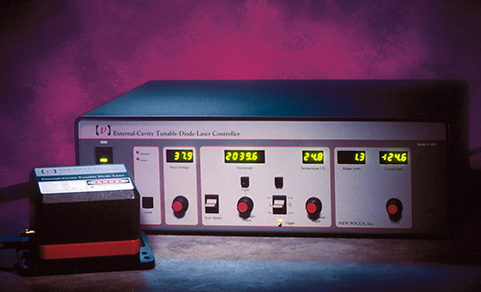Breaking the Wavelength Barrier
Compact, inexpensive lasers are of growing interest because of a diverse suite of applications in global climate monitoring, as well as medical diagnostics and process control. Many organic compounds, including hazardous effluents, have characteristic absorption spectra in the wavelength region of 2-4 microns. But attaining these wavelengths in convenient room-temperature diode lasers was considered a tough, technological challenge.
New Focus, Inc., Santa Clara, California, has been busy at work, tackling a new frontier of laser technology. Company work in the area has been aided by Small Business Innovation Research (SBIR) awards from Goddard Space Flight Center. SBIR funds have melded the talents of New Focus, its research and development subsidiary, Focused Research, Inc. (FRI), also of Santa Clara, and with subcontractor Sarnoff Corporation of Princeton, New Jersey.
FRI does the research for innovative products that require a longer development time than most New Focus products. FRI partners with leading research groups in universities, industry, and government to work on the leading edge of optical technology. New Focus provides the ultimate link to commercialization through its manufacturing and marketing skills in the photonics community. FRI's objectives are to maximize the return on research and development investments by providing low cost and innovative solutions to problems for government and commercial customers.
FRI and New Focus, working with Sarnoff, have developed single-mode tunable diode lasers with center wavelengths from 1.9 microns to 2.3 microns. As an offshoot from this work, New Focus was able to introduce the 2.0 micron external cavity diode laser into their commercial product line. These lasers are expected to be particularly useful in applications such as medical diagnostic experiments, trace gas detection, environmental sensing, and optical seeding of lidar (laser radar) systems. Advancing these state-of-the-art laser systems has also driven advances in materials engineering and anti-reflection coatings.
New Focus has set out to become a leading supplier of photonics research tools. The company has six product lines: tunable lasers, high performance photodetectors and receivers, laser modulators, electro-optic instruments, mechanical positioners, and optical components. The company has established a solid presence and reputation in the marketplace. New Focus has commercialized a suite of ultra-narrow linewidth diode lasers that are tunable over a broad range of frequencies. The lasers are user-friendly, reliable, and reasonably priced. An ongoing objective of New Focus is developing products with advanced capabilities at low cost.
For the government, its interests are in rapid technology development and commercialization with with concern that future suppliers who are capable, interested, and have the infrastructure to achieve low-cost manufacturing are available.

A custom-designed 2.0 micron diode laser has been developed, a level of capability that should prove commercially important, as well as valuable to the scientific community.













